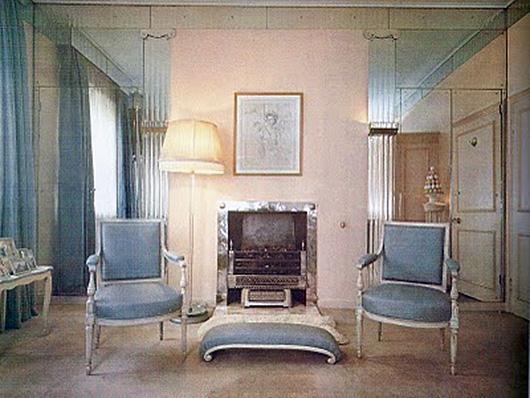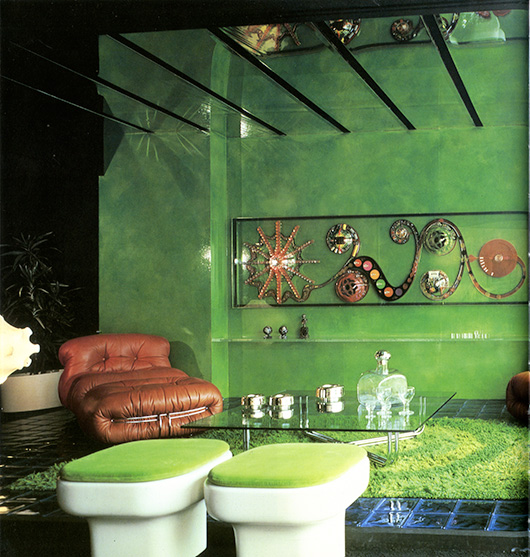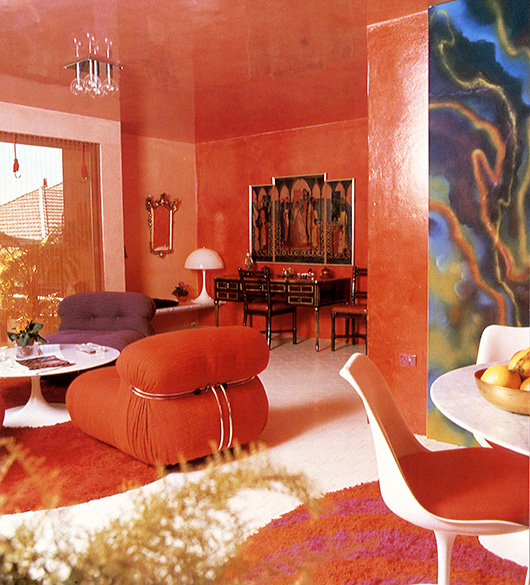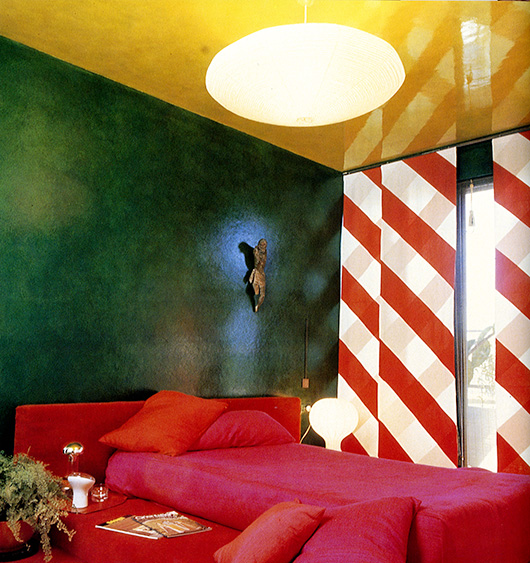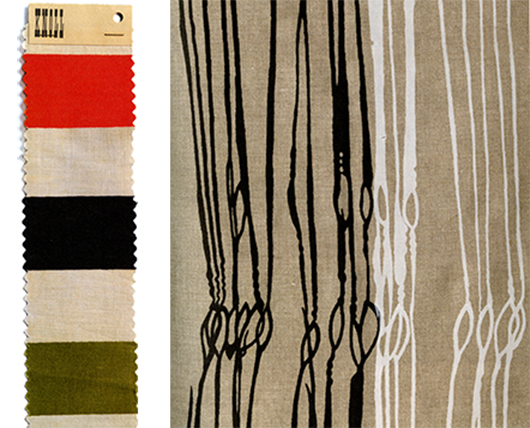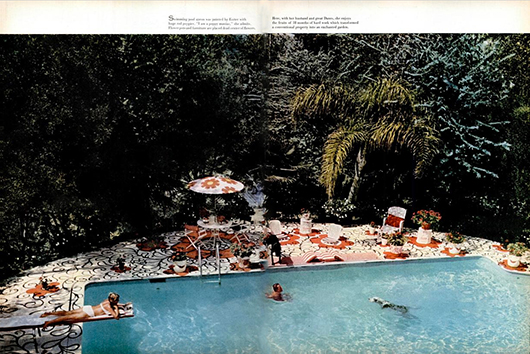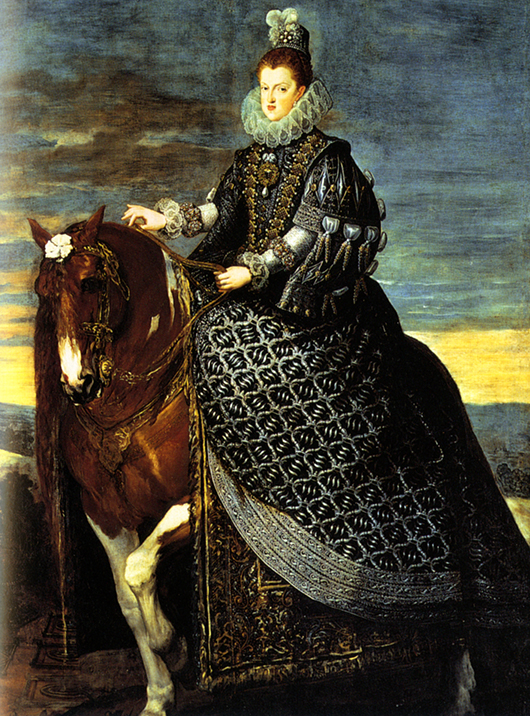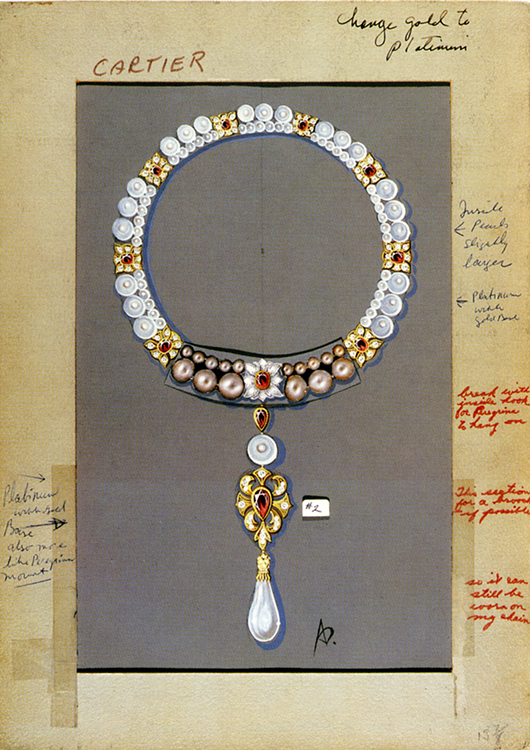Women from History: Swank Elsie de Wolfe
The young artist, Cecil Beaton, met and sketched interior decorator Elsie de Wolfe in New York in 1929. He was much younger than her but he liked her at once calling de Wolfe "the sort of wildly grotesque artificial creature I adore".
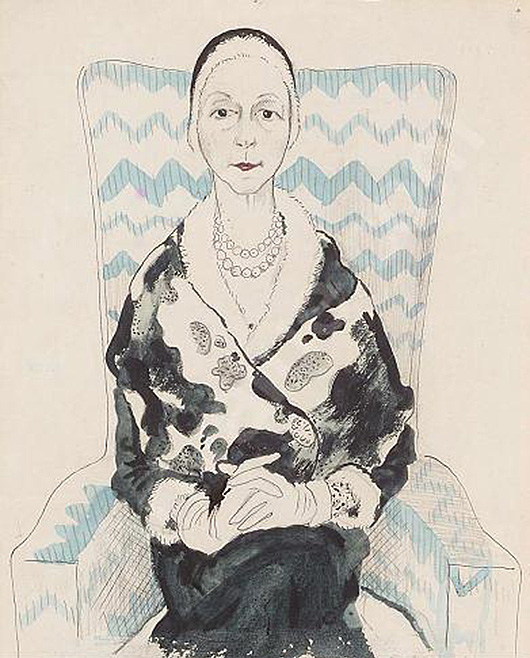
Elsie de Wolfe had middling success as a stage actor.
Her real success came after she changed direction and became an important American tastemaker. A lady decorator.
One of her most famous interiors was for the first female only club in New York, the Colony Club.
This is the Trellis Room.
And the Strangers' Room
In 1915 she published The House in Good Taste. A natty book on all things refined in the home. But also a treatise on the idea of women's spaces. A space made by women after the men have played their architectural part.
"It is the personality of the mistress that the home expresses. Men are forever guests in our homes, no matter how much happiness they may find there."
De Wolf also had some particular ideas on colour.
"If you are inclined to a hasty temper, for instance, you should not live in a room in which the prevailing note is red. On the other hand, a timid, delicate nature could often gain courage and poise by living in surroundings of rich red tones."
In 1938 Janet Flanner wrote a story about de Wolf in The New Yorker.
"She was a wizard saleswoman. She made money because she likes money and is vulnerable to it, because she has a true, talented eye for color, because she loved the job, and above all because the time was ripe for the work. Women clients liked her because she planned plenty of closets and was practically the mother of modern lampshades; also, she had an inventive efficiency unafraid to mix the practical and lovely.
"She is today a lively little figure with artfully coiffed pale green hair, squirrel-brown eyes, an alert, inquiring, small chic face, and neat tiny feet in low-heeled shoes. She has an air of being an eccentric, entertaining, highly compact, energetic personality. She has been called one of the world's best-dressed women and probably is, since she sensibly gets beautiful Parisian clothes which are simple, fit perfectly, aren't ephemeral or startling in style, and which she generally wears two or three years. She wears chiefly blue or black, and used to adore beige. When she first looked at the Parthenon in Athens, she cried, 'It's beige—just my color!'"
This elegant sitting room from the thirties represents the work of de Wolfe's glamourous lady rooms. Gleaming mirrors, pale walls and painted furniture with soft blue fabrics.
And by the way she was a fitness freak.
And, this is the best bit, at her home in France, the Villa Trianon, she had a dog cemetery in which each tombstone read, "The one I loved the best."
A swanky creature.
Julia Ritson is a Melbourne artist. Her paintings investigate colour, abstraction and a long-standing fascination with the grid. Julia has enriched and extended her studio practice with a series of limited edition art scarves. She also produces an online journal dedicated to art and scarves and architecture.
Women from History: Best Modern Sydney
Marion Hall Best (nee Burkitt) attended Thea Proctor’s art and design classes in Sydney. Another country girl. Along with her painter sister Dora Sweetapple. Marion studied architecture for a year and became intrigued with the ideas of Harry Seidler and Buckminster Fuller. This was a time when women were seen merely as decorators. Marion always thought of herself as a designer.
She became very good at bouncing walls apart. She set up shop in Queen Street Woollahra as Sydney's first interior designer and became an expert in all things modern.
From 1951, Best worked as a founding member of the Society of Interior Designers of Australia (SIDA) to encourage public recognition of designers and to improve professional standards.
Best became known for her exhibition rooms, or 'personality' rooms. In these room she was able to express her new ideas untroubled by pesky clients or market demands.
In this case, a 'Room for Peter Sculthorpe.' The vivid green glazes showcase a Jack Meyer's musical sculpture, Magistretti table, Tobia Scarpa leather seats, and Architectural Fibreglass indoor/outdoor furniture.
Glazes became her forte. Layers of transparent paint thoughtfully applied to walls.
This stunning guest cottage in Castlecrag was designed for clients who were very open to Best's High Style.
She admitted "I just did to architectural finishes what friends who were artists were doing to their paintings". Friends like Justin O’Brien. The undercoat was an equal mixture of flat and enamel house paint, and the contrasting glaze a coat of Dulux gloss stained with translucent artists’ oils.
"It was the glazing technique that made the colours sing with such freedom and varying depth only possible with this new found technique. I was interested in Justin O'Brien's technique in oil painting of overlaying a heavy colour over a singing light one such as olive over a brilliant yellow, then scraping it off to a varying scale of transparency. The same with the reds overlaid over pink or greens or rich yellow, whichever he had in mind, and scraped away to such varying transparency of colour, tone and movement. It was this subtlety that made me realise the importance in glazing technique of the choice in undercoat colour for maximum subtlety or brilliance. There was no end to this beautiful discovery, and the variety and contrast of scale from light to dark is thrilling."
Makes for a thrilling apartment.
"Colours were never thoughtlessly used. If one wants to be spun into orbit on fabulous vibrant colour, with an emerald room off a vermilion room, the effects can be magical if other colours in the right scale and tone appear in paintings or through open doors, or mirrors; but is must be planned, and it must look free and not contrived. Whether high or low tone, the same applies. So too the pattern - they can mix, as Matisse has shown us but it is for the highly trained to do and not a salesman of wallpapers. Never for novelty and only a very high plane of intellectual artistry."
Thoroughly modern Marion.
Julia Ritson is a Melbourne artist. Her paintings investigate colour, abstraction and a long-standing fascination with the grid. Julia has enriched and extended her studio practice with a series of limited edition art scarves. She also produces an online journal dedicated to art and scarves and architecture.
Women from History: Margaret Preston's Rules
By Julia Ritson Magaret Preston was a formidable artist and an inspiring teacher who was interested in everything.
I'm drawn to her domestic scenes from the 1910s. Scenes played out in a modern world within a landscape of war.
A device she used in many of her flower paintings was the table cloth. The cloth enabled the artist to emphasise the shallow space, pushing all to the front of the picture plane. An abstraction.
Red, white, blue and black plaid in this painting. Preston is starting to experiment with the flattening of space. When you see these paintings in the flesh, you get a better idea of her use of empty areas to provide light to the overall design.
Margaret Preston, Holiday still life, 1913
In this painting she uses an indoor/outdoor concept with the cloth playing a large part.
Preston said "why there are so many tables of still life in modern paintings is because they are really laboratory tables on which aesthetic problems can be isolated."
Margaret Preston, Still life sunshine indoors, 1914
The red and white gingham in this painting adds an unpretentious element to the complexity of the picture plane.
A wonderful use of black in the lacquer tray alongside the black border pushes the composition into edgy territory.
Margaret Preston, Still life, 1915
In this painting you get to experience Preston's love of white paint in all its chalkiness.
The pink and white striped cloth is reflected charmingly in the shiny tea pot.
Margaret Preson, Still life with teapot and daisies, 1915
Preston was also a prolific writer. One of her quirkier works was a piece she wrote for The Home in 1926 with instructions for furnishing a bedroom.
Mrs Margaret Preston makes some practical suggestions for arranging a bedroom, keeping in mind that it is the most intimate room in the house.
WALLS Painted in a pale colour, preferably cream or pink.
WOODWORK Light in colour, matt in surface work.
CEILING Plain white, small decorated line separating walls from ceiling.
FLOOR Seagrass mat, not too big, so that it can be taken up each week. Outside borders of boards stained or painted. Grey soft mats for the bedside etc.
MANTEL If made of wood, stained a bright colour to match mats and curtains.
ON THE MANTEL No draperies; a few intimate possessions and a few pet books; coloured line mats. Needlework (samples) framed, or a water colour painting - a gaily coloured print would do. No oil paintings in a bedroom.
CURTAINS Washing material, something with a bright stripe. Keep rather short.
FURNITURE Single beds of wood and cane; two or three chairs, one an easy chair with a slip-on cretonne cover, one with a straight back for the dressing table; a low, wide dressing table - all straight lines except the oval mirror. The woodwork to be of a very highly polished and the dressing table effects glittering silver or glass.
PICTURE Water colours or prints.
ORNAMENTS, LAMPS, ETC No ornaments. No top lights; they make shadows in the mirror.
The world according to Mrs Preston.
Julia Ritson is a Melbourne artist. Her paintings investigate colour, abstraction and a long-standing fascination with the grid. Julia has enriched and extended her studio practice with a series of limited edition art scarves. She also produces an online journal dedicated to art and scarves and architecture.
The year that was: Women from History
{Throughout January, we’re looking back at all the posts our awesome columnists wrote for us in 2012, before our team of some new and some returning contributors start blogging in February.} Julia Ritson is an artist, whose love and respect for those who came before her is obvious through her thoughtful, informative posts for Women from History. Textile artists, painters, boundary-pushers, trailblazers. Julia has been a fantastic tour guide through the shining stars of yesteryear. Thanks, Julia! x tess
Thinking Bridget Riley The 80-year-old Bridget Riley has been on my mind a lot lately. Read more...
........................................................................................
Distinct Delaunay There are a myriad of ways to view Sonia Delaunay. Painter, colourist, textile designer, mother, and wife, Delaunay returns to Paris in the middle of a world-wide shift. The new jazzy world of the 1920s. In response to the cultural change in the air, there was a whole lot of new women stereotyping going on. Read more...
........................................................................................
Original Gray Eileen Gray (1879-1976) was born in Ireland but lived in Paris. A thoroughly modern lady designing furniture while surrounded by the world of French couture. Read more...
........................................................................................
Tauber-Arp’s Dance Sophie Tauber-Arp’s work was all about form and colour, rhythm and balance. Trained as a textile designer, Tauber-Arp works the grid lovingly. The warp and the weft. The abundant stitches marching up, down, left, right create a beautifully rhythmical work. Read more...
........................................................................................
Maude’s Coo-ee! Maude Wordsworth James was completely obsessed by the word ‘coo-ee.’ Read more...
........................................................................................
Girl Painter “Girl Painter Who Won Art Prize is also Good Cook.” That’s the 1939 headline for a story about Nora Heysen in The Australian Women’s Weekly. It just so happened she was the first female artist to win the Archibald prize – just as well she could cook. Read more...
........................................................................................
Cool Albers “I find that a craft gives somebody who is trying to find their way a kind of discipline.” Read more...
........................................................................................
Non Objective Grace Crowley Just before Australian artist Grace Crowley died in 1979, she bequeathed the few remaining paintings in her possession to Australian art museums and her papers to the Art Gallery of New South Wales. Read more...
........................................................................................
Grace Cossington Smith Sydney born Grace Cossington Smith painted this work in 1915 and lucky for us Daniel Thomas convinced the Art Gallery of NSW to add it to their collection in 1960. It was from one of her first exhibitions. She was 23 years old. Read more...
........................................................................................
Radiant Elizabeth Taylor Elizabeth Taylor was a real dame. Her penchant for shops in the arcades of swish hotels led to her developing a breathtaking collection of jewellery. Read more...
........................................................................................
Ebullient Eszter Haraszty When flicking through the mammoth Knoll Textiles‘ catalogue, published by Yale University Press, Eszter Haraszty’s work really stands out for me. Read more...
Women in Art: Dealing with the past
By Lauren Treiser For my grand finale post on Women in Art I decided to visit the spectacular Heide Museum of Modern Art. Currently there are two exhibitions featuring the work of Louise Bourgeois (1911 – 2010). The first, Louise Bourgeois: Late Works is direct from the late artist’s studio in New York. The second exhibition, Louise Bourgeois and Australian Artists presents a selection of works by contemporary Australian artists who have been inspired by Bourgeois alongside her prints and drawings. This is the first exhibition in Australia since 1995 when the NGV had a major exhibition of Bourgeois’ works.
 Left: Louise Bourgeois, 2009, Photograph: Alex Van Gelder
Right: Cinq 2007
fabric, stainless steel (61 × 35.6 × 35.6 cm)
Courtesy Cheim & Read and Hauser & Wirth
Photograph: Christopher Burke
© Louise Bourgeois Trust / Licensed by VAGA, New York / Viscopy, Sydney
Left: Louise Bourgeois, 2009, Photograph: Alex Van Gelder
Right: Cinq 2007
fabric, stainless steel (61 × 35.6 × 35.6 cm)
Courtesy Cheim & Read and Hauser & Wirth
Photograph: Christopher Burke
© Louise Bourgeois Trust / Licensed by VAGA, New York / Viscopy, Sydney
Louise Bourgeois: Late Works, in the main gallery, focuses on the final fifteen years of Louise Bourgeois’ career. Prior to my visit I was unaware of Bourgeois’ work but she was an incredibly prolific artist and I feel lucky to now know a little bit about her. She was creating art right to the end of her life and even some of the large scale sculptures were created, with assistance, when she was in her nineties. The show examines the use of fabric in her works, and includes sculptures, suites of fabric drawings, watercolours, embroidered texts and lithographs.
The stories that provided life-long fuel for Bourgeois’ art are well known: her parents’ tapestry workshop in which she learnt how a needle could be a tool with reparative qualities; her father’s public infidelity; her mother’s early death; her constant analysis of self; her belief in art as a potential reconciliation with the past. This all equates to her work being quite dark and disturbing but nevertheless interesting.
One of her written pieces in the show states, ‘Art is a guaranty of sanity.’ Art became her whole life; it helped her deal with her anxiety, betrayal, frustration and disgust for her father. She created art to express emotion. Most pieces in this exhibition use her families old clothes and parts of fabric from her parent’s tapestry workshop. Whilst they hold a lot of meaning for the artist, often the meaning is ambiguous to the viewer.
 Spider 1997
steel, tapestry, wood, glass, fabric, rubber, silver, gold, bone (449.6 × 665.5 × 518.2 cm)
The Easton Foundation, New York, NY
Photograph: John Gollings 2012
© Louise Bourgeois Trust / Licensed by VAGA, New York / Viscopy, Sydney
Spider 1997
steel, tapestry, wood, glass, fabric, rubber, silver, gold, bone (449.6 × 665.5 × 518.2 cm)
The Easton Foundation, New York, NY
Photograph: John Gollings 2012
© Louise Bourgeois Trust / Licensed by VAGA, New York / Viscopy, Sydney
Central to the exhibition is Spider, 1997 one of the Bourgeois’ Cells sculptures which is dominated, enclosed and protected by a ginormous spider – a recurring and powerful motif in the artist’s work. Bourgeois created her spider sculptures in tribute to her mother, saying: 'Like a spider, my mother was a weaver. Spiders are helpful and protective, just like my mother'.
 Couple IV 1997
fabric, leather, stainless steel, plastic (50.8 × 165.1 × 77.5 cm)
Courtesy Cheim & Read and Hauser & Wirth
Photograph: Christopher Burke
© Louise Bourgeois Trust / Licensed by VAGA, New York / Viscopy, Sydney
Couple IV 1997
fabric, leather, stainless steel, plastic (50.8 × 165.1 × 77.5 cm)
Courtesy Cheim & Read and Hauser & Wirth
Photograph: Christopher Burke
© Louise Bourgeois Trust / Licensed by VAGA, New York / Viscopy, Sydney
Another highlight of the exhibition is the haunting Couple IV 1997, depicting a pair of copulating, and decapitated lovers. The embracing figures are portrayed in black, and appear as an encased specimen in the vitrine. Looking in, one gets a sense of Bourgeois’ feelings of being a voyeur whilst growing up.
 Femme Maison (2001)
Picture: Christopher Burke
Femme Maison (2001)
Picture: Christopher Burke
Bourgeois started drawing pictures of half women and half houses in the 1940’s. ‘Femme Maison’ dealt with issues of domesticity and the roles of women. This piece can be read in numerous ways, it could indicating that a house could take over a woman’s life, but also the house couldn't exist without the woman. She kept revisiting this idea of a woman and a house combined in her work. Her other sculptures in the show are far more sinister.
 Untitled 2002
Fabric, steel and wood (35.6 x 38.1 x 15.2 cm)
Courtesy Cheim & Read and Hauser & Wirth
Photograph: Christopher Burke,
© Louise Bourgeois Trust/ Licensed by VAGA, New York / Viscopy, Sydney
Untitled 2002
Fabric, steel and wood (35.6 x 38.1 x 15.2 cm)
Courtesy Cheim & Read and Hauser & Wirth
Photograph: Christopher Burke,
© Louise Bourgeois Trust/ Licensed by VAGA, New York / Viscopy, Sydney
Inspired by surrealism Bourgeois’ small scale sculptures combines dismembered torsos made from material and kitchen utensils. On the one hand the shapes are soft and tender and on the other hand they are quite ominous.
 Knife Figure 2002
fabric, steel, wood (22.2 × 76.2 × 19.1 cm)
Courtesy Cheim & Read and Hauser & Wirth
Photograph: Christopher Burke
© Louise Bourgeois Trust / Licensed by VAGA, New York / Viscopy, Sydney
Knife Figure 2002
fabric, steel, wood (22.2 × 76.2 × 19.1 cm)
Courtesy Cheim & Read and Hauser & Wirth
Photograph: Christopher Burke
© Louise Bourgeois Trust / Licensed by VAGA, New York / Viscopy, Sydney
The pieces in the show deal with the artist’s raw emotion and are imbued with heaviness but nevertheless are incredible. What an amazing and prolific artist she was! There is still plenty of time to see this exhibition and with Café Vue on the grounds, there is no excuse to miss it!
Louise Bourgeois: Late Works 24 November – 11 March 2013 Heide Museum of Modern Art 7 Templestowe Road, Bulleen Tuesday – Sunday 10am – 5pm Closed Mondays
Lauren is graphic designer and founder of patchyrugs.com.au. She loves all things design (see her blog at blog.ilovelollies.net) and is particularly passionate about fine art, interior design and jewellery. Lauren is currently studying Gold & Silversmithing and doing graphic design on a freelance basis.
Women from History: Ebullient Eszter Haraszty
By Julia Ritson When flicking through the mammoth Knoll Textiles' catalogue, published by Yale University Press, Eszter Haraszty's work really stands out for me.
Haraszty studied painting and art history in Budapest but had to leave Hungary due to the German occupation in World War II. Haraszty ended up in New York city living with Marcela and Constance Breuer.
She found work with Hans Knoll. At the time, Knoll was going through a company wide re-focus on the importance of colour. And in the process, Haraszty became Knoll's Chief Colourist.
Her ability to re-think colour led to some long lasting classics. The swatch on the left is called Knoll Stripes. Love the combination of the primary red with olive. The company publicity described these colours as "clear sunlight tones... mixed spontaneously with... deep rustic tones of olive, charcoal and rust."
The swatch on the right is inspired by heddles on a loom (the bit that separates the warp from the weft). Beautiful work.
For six years, she played around with many exotic and striking hues. All brilliantly exciting.
Sadly she didn't really get on with Florence Knoll so when Hans Knoll died, Haraszty lost her chief champion in the firm.
So it was off to California where her love of embroidery flourished.
There is a wonderful spread in a 1962 Life magazine featuring the property she patterned.
Flamboyant Eszter.
Dramatic Eszter on her bed with Pancake.
Eszter poolside in her enchanted garden.
She filled the house with flowers that she had grown, designed her own floral tiles, embroidered flowers on all the furnishings, and hung flower paintings.
She was even known to paint poppies on her toenails.
Flower powering her life.
And here is Haraszty in the 1970s holding a copy of one of her books on embroidery.
She made the world more beautiful for all to see.
Julia Ritson is a Melbourne artist. Her paintings investigate colour, abstraction and a long-standing fascination with the grid. Julia has enriched and extended her studio practice with a series of limited edition art scarves. She also produces an online journal dedicated to art and scarves and architecture.
Women from History: Radiant Elizabeth Taylor
By Julia Ritson Elizabeth Taylor was a real dame.
Her penchant for shops in the arcades of swish hotels led to her developing a breathtaking collection of jewellery.
A perfect partner for the history loving Richard Burton. When Burton heard that the La Peregrina pearl was on the market, he just had to have it. He loved the provenance.
Here is Liz is wearing the very famous La Peregrina pearl, topped up with many other pearls.
The single pearl was found by a slave in 1500 and was passed on around the world, ending up as part of the Spanish royal jewels.
Other famous women have worn this very large pearl. In this wonderful 1634 painting by Diego Velázquez, we see Queen Margarita of Spain wearing the pearl set as a brooch.
After the purchase in 1969, Burton and Taylor approached Cartier to set the very special pearl in a new way. They were inspired by a portrait of Mary Queens of Scots wearing another pearl necklace and asked Cartier for a similar setting.
This image shows the collaboration between Cartier designer Al Durante and Taylor.
Taylor's life was full of drama.
Here she relates a story about losing the pearl. "At one point I reached down to touch La Peregrina and it wasn't there! I glanced over at Richard and thank God he wasn't looking at me, and I went into the bedroom and threw myself on the bed, buried my head into the pillow and screamed. Very slowly and very carefully, I retraced all my steps. I took my slippers off, took my socks off, and got down on my hands and knees, looking everywhere for the pearl. Nothing. I thought, 'It's got to be in the living room in front of Richard. What am I going to do. He'll kill me! Because he loved the piece!'" Taylor then looked at one of their puppies which seemed to have something in its mouth. "I casually opened the puppy's mouth and inside was the most perfect pearl in the world. It was, thank God, not scratched."
What a dame.
Julia Ritson is a Melbourne artist. Her paintings investigate colour, abstraction and a long-standing fascination with the grid. Julia has enriched and extended her studio practice with a series of limited edition art scarves. She also produces an online journal dedicated to art and scarves and architecture.



